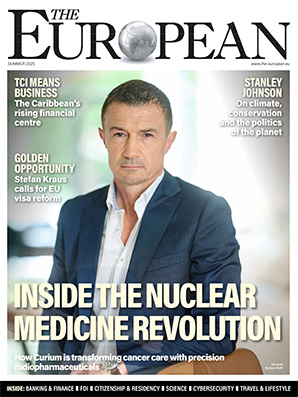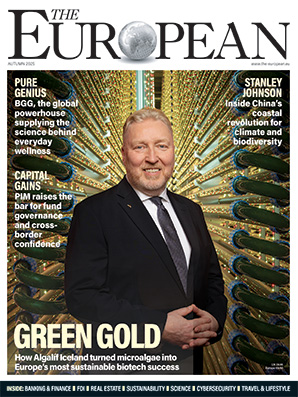Realising sustainable and economical ship dismantling dreams

The topic of ship dismantling is a matter of commercial, environmental, political, and human interest. With the impending opening of the multi-million dollar Panama Canal expansion – which will see a dramatic increase in the size of ships able to navigate this Central American shipping corridor – the current global fleet of Panamax vessels could become economically obsolete and bound for the murky world of ship dismantling.
But according to Marius van der Stoel, Director and founder of Dutch engineering firm Greendock, ship owners and brokers could do their wallets – and conscience – a huge favour when the time comes to send a vessel on its final journey by opting for an evolutionary and eco-friendly new concept. The Foil Dock idea could, believes its creator, see the ship dismantling industry transformed into a well-regulated, HSE-aware global industry. Seeking further investment to see his vision realised, Marius chatted to Daniel Barnes.
Daniel Barnes: Please tell me the reasons behind the creation of Greendock. How long has it taken you to get to where you are today?
Marius van der Stoel: We found that there was a problem in the world which was well discussed but had no viable solution: how to recycle large commercial vessels. Up until six or seven years ago it was basically done on far away beaches in India, Bangladesh and Pakistan before it was banned by the EU. It was a terrible practice because of the damage it did to the local environment, and also because of how unsafe it was. A lot of casualties occur when they dismantle a vessel – deaths are very common – and this is before you consider the longer-term effects of dealing with harmful substances such as asbestos without any of the necessary protection.
So the main alternative at the moment is to send vessels to China or Turkey where they are demolished or dismantled alongside a quay. This is a very expensive way of doing it, because a quayside was never designed as a demolition yard. It is not 100% sustainable as there are spills and leakages along this quayside. It is however a big improvement in comparison to the practice of beaching.
But we thought we could offer another, more attractive alternative. We have developed a concept which was both sustainable and economical – the Foil Dock. Our objective now is to bring the various parties involved in such a project – the business community, the political arena, harbour authorities, pressure groups and financers – together in a collaborative arrangement that would result in a profitable ship dismantling business that works in an environmentally friendly manner with humane working conditions.
DB: Could you walk me through this concept?
MS: First of all, this new concept makes it possible to build a dry dock at 10% of the cost price compared with a traditional dry dock. Specially designed for scrapping large commercial vessels, by applying efficient working methods, we believe a vessel can be scrapped in two weeks resulting in very competitive scrapping prices for sustainable ship dismantling to be offered to the relevant ship owners.
It is not the conventional shape of a traditional dry dock; the whole dock has been designed solely for dismantling and recycling ships, creating the optimal environment for this process.
When we finalised this development, we conducted a comprehensive feasibility study and business plan, which was presented to the German development bank, DEG. That was very well received and DEG is in principal, prepared to play a large role in its financing. And this is the position we find ourselves in today – seeking further investment so we can finally solve the problem of sustainable solutions for ship recycling.
We are in talks with several interested parties, but we are still in the development phase. The feasibility study we have produced includes a business plan, organisational structure and financial requirements where we have worked out a sensibility scenario based on various financial models, so it is very detailed.
© Architektenburo De Jonge bvDB: What has the feedback been like so far from the industry?
MS: It has been very positive! When I introduce my plans to everyone – from government authorities to technicians and consultants – the response I get is ‘Please continue because you have a very good idea!’ The enthusiasm I have received during this process gives me the power and motivation to go forward.
We have also participated in EU workshops with some very enthusiastic people and we have visited several shipping companies, the Norwegian Shipping Association and also Hapag-Lloyd in Hamburg who said they were very interested to see Greendock’s concept brought to life.
In 2014, Hapag-Lloyd dismantled, I believe, over a dozen vessels in China or Turkey. We calculated the price per tonnage of what it currently costs to clean it up and to make scrap out of it and when you compare us to existing practices, we are very competitive. So a number of companies have expressed an interest to cooperate once we are up and running.
DB: Who else works on these matters with you at Greendock?
MS: We have a small team, including engineers, financial consultants, organisational consultants; we teamed up with a small team of ten people which we can adapt and be flexible with for the solution we are looking at. With that team, we also conducted these studies. We have also developed an organisational structure to operate a Greendock facility.
We already have a blueprint to start with a Greendock: We know the financial items, the operational items, and we have a team to implement them. We are aiming at a delivery on a turnkey basis.
Marius van der StoelDB: Are there particular vessel types that you are targeting with the Greendock concept?
MS: We are looking at the size of the Panamax vessel. If you look at the widening of the Panama Canal, these existing Panamax vessels will basically become too small. They will not be competitive in modern shipping, so they will be a burden for each ship owner.
The feasibility study examined this market intensively. We have used mathematical models from the University of Groningen to predict the number of vessels, which will be offered for recycling in the near future, and we see an increasing number of hundreds of ships per year. Less than a decade ago, this number would have been at just ten or 20 vessels per year: in the near future, you will see 100 or 200 of these vessels offered for recycling.
We think we can demolish one Panamax vessel in two weeks. So with 100% utilisation, a Foil Dock could work on 24 vessels a year. Of course, in our models, we also looked at utilisation degrees which are significantly lower. These docks could also dismantle two handy-sized vessels simultaneously to maintain volume levels.
DB: Where in the world do you envisage a Greendock ship recycling facility being implemented?
MS: If you look at all of the aspects, you have to locate your ship recycling facility where the ship scrap clients are, which is Asia. Ships are built of certified steel of a very high quality which can be used as a resource for steel manufacturers. The uses for the scrap metal include re-rolling mills and electric arc furnaces.
In the past these electric arc furnaces couldn’t accept shipping plates from the beaching industry because the steel plates were cut too large. The smaller you have to cut it, the more expensive it becomes. The old beaching method of cutting was with gas. Whilst the people are paid very poorly, gas is still very expensive. But rather than use gas, our method includes the use of hydraulic shears, meaning we can cut the steel to an acceptable size at a reasonable cost.
DB: Can you put a timescale on your first Foil Dock becoming operational?
MS: Once a leading investor steps in, we have a plan to develop it between 18 or 24 months to commence operations.
DB: You have invested an enormous amount of time into this concept. How optimistic are you of seeing it realised?
MS: I’m absolutely sure this will happen because it is such a competitive alternative. I know exactly the price of demolishing by existing practices, and we have detailed calculations that we can offer a significantly lower price, and still have a profit. In our models, we have an internal rate of return of between 20% (worst case scenario) and 50% (best case scenario).
It is a very interesting and sound proposition for an investor; the market is there, the clients are there and we have several letters of intent from the steel manufacturers who want to buy the total yearly production.
Our concept is not only based on the Foil Dock, our concept is also based upon integrating pre-cleaning into the total scrapping process. We have the environment for that; the dry dock creates the environment for far more efficiency in the whole process. A quayside is not the right environment in which to demolish a vessel.
DB: Have you visited any of these beaches in India or Bangladesh yourself?
MS: Frequently. I know these people; they are very enthusiastic about our ideas and concepts, because they have no alternatives.
It is the broker who rules the business. He buys the vessels, and he sells the scrap. He goes to Bangladesh and offers the vessel to the people working there, and they have no influence at all on the process – they do the dirty work for practically nothing – just a couple of dollars a day.
DB: So will you have an emphasis on training and educating the local workforces who used to work on beached vessels?
MS: Absolutely. We will change the dirty and dangerous work into proper qualified and safe work. We would introduce lean and zero accident principles.
This would enable us to implement management systems like ISO 31000 risk management and the ISO 30,000 ship recycling management system – a specific management system for safe and environmentally sound ship recycling facilities. No ship-recycling yard has ever been awarded the latter, because they do not have the environmental practices.
If you create an environment like you have in, for example, the automotive industry, you can use lean principles, which makes your process very efficient. That is also included in our concept; not only in the Foil Dock, but also in the labour process, or working method as you call it.
DB: Moving forward, what is the biggest challenge you face?
MS: Finding the right investor who wants to start the first Greendock facility in the world; it’s as simple as that. Once the first dry dock is up and running, we will be very successful.
This article was first published in the April/May 2016 edition of Inside Marine magazine – www.insidemarine.com


